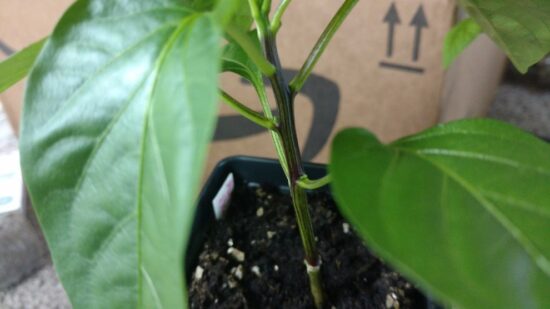Are you noticing purple stems on your pepper plants and wondering what could be causing this? Well, you’re in the right place! Purple stems on pepper plants can be a sign of a nutrient deficiency or even a pest infestation.
But fear not, because in this article, we will explore the possible causes of purple stems and provide you with practical solutions to get your pepper plants back to optimal health. So, if you’re ready to dive into the world of purple stems on pepper plants, let’s get started!
Purple Stems on Pepper Plants: Causes, Symptoms, and Solutions
Pepper plants are a popular choice for home gardeners, thanks to their vibrant colors, spicy flavors, and versatility in various culinary creations. However, it can be concerning when you notice that the stems of your pepper plants are turning purple.
In this article, we will delve into the causes, symptoms, and solutions for purple stems on pepper plants, enabling you to address the issue and ensure the health and productivity of your beloved pepper plants.
Understanding the Importance of Healthy Stems
Before we explore the reasons behind purple stems on pepper plants, it’s essential to understand the significance of healthy stems. Stems serve as the backbone of a plant, providing structural support and transporting vital nutrients and water throughout the plant.
They also house the plant’s vascular system responsible for these functions. When stems encounter abnormalities, such as turning purple, it can indicate an underlying problem that requires attention.
Possible Causes of Purple Stems on Pepper Plants
There are several potential reasons why the stems of your pepper plants may be turning purple. Let’s examine each possible cause in detail:
1. Phosphorus Deficiency
One of the leading causes of purple stems in pepper plants is a phosphorus deficiency. Phosphorus is an essential macronutrient required for various metabolic processes within the plant. When there is a lack of phosphorus, the plant’s growth and development are hindered, often resulting in purple stems.
Other symptoms of phosphorus deficiency may include stunted growth, dark green leaves, and reduced flower production.
2. Low Temperatures
Exposure to cold temperatures can also lead to purple stems on pepper plants. Cold stress restricts the plant’s ability to take up nutrients efficiently, including phosphorus. This limitation can result in the accumulation of anthocyanins, which are pigments responsible for the purple coloration.
Additionally, low temperatures can damage the plant’s cells and impede its vascular system, further contributing to purple stems.
3. High Light Intensity
While pepper plants require ample sunlight for growth, excessive light intensity can cause the stems to turn purple. When plants are exposed to intense light, they produce excess energy that can damage the plant’s cells.
In response, the plant initiates various defense mechanisms, including the production of anthocyanins. As a result, the stems may exhibit purple discoloration.
4. Genetic Factors
In some cases, purple stems on pepper plants can be attributed to genetic factors. Certain pepper varieties naturally possess anthocyanin pigments, which can manifest as purple stems.
If you are growing a pepper variety known for its purple stems, genetic factors are likely responsible for the discoloration.
Read More: About How to Start Seeds for Hydroponics Successfully?
Identifying Symptoms of Purple Stems on Pepper Plants
To effectively address the issue of purple stems on your pepper plants, it’s crucial to accurately identify the symptoms. Here are some common signs that indicate the presence of purple stems:
- Purple or reddish discoloration on the stems
- Stunted growth or slow development
- Abnormal leaf coloration or yellowing
- Reduced flower production
- Wilting or drooping of leaves
By closely observing your pepper plants and noting these symptoms, you can determine the severity of the issue and take appropriate action.
Solutions for Dealing with Purple Stems
Once you have identified the cause of purple stems on your pepper plants, it’s time to implement the necessary solutions. Let’s explore some strategies for effectively dealing with this issue:
1. Adjusting Nutrient Levels
If a phosphorus deficiency is the root cause, it’s crucial to address this nutrient imbalance. Consider the following steps:
- Apply a phosphorus-rich fertilizer, such as bone meal or rock phosphate, according to the package instructions.
- Ensure the soil pH is within the optimal range for phosphorus availability, typically between 6.0 and 7.0.
- Regularly test the soil to monitor nutrient levels and make any necessary adjustments.
By rectifying phosphorus deficiencies, you can promote healthy growth and prevent further purple discoloration.
2. Protecting from Cold Temperatures
To safeguard your pepper plants from the adverse effects of low temperatures, consider the following protective measures:
- Plant peppers after the danger of frost has passed.
- Cover the plants with plastic or fabric row covers during cold nights.
- Utilize mulch to insulate the soil and retain warmth.
- Consider using portable greenhouses or cold frames for extended protection.
By providing adequate warmth and protection, you can minimize the risk of purple stems due to cold stress.
3. Managing Light Exposure
To regulate light intensity and prevent excessive energy production, follow these recommendations:
- Ensure your pepper plants receive the recommended amount of sunlight for their specific variety.
- Install shading devices or use lightweight, breathable fabrics to diffuse intense sunlight.
- Adjust the positioning of plants or use temporary screens to provide partial shade during peak sun hours.
By finding the right balance between light intensity and shade, you can mitigate the risk of purple stems caused by excessive sunlight.
4. Embracing Genetic Variability
If the purple stems on your pepper plants are a result of genetic factors, there is no cause for concern. Embrace the unique characteristics of your pepper variety and appreciate the vibrant purple stems as a natural attribute.
Maintaining Healthy Pepper Plants
Beyond addressing the issue of purple stems, it’s essential to maintain overall plant health for optimal growth and productivity. Consider the following tips to ensure the well-being of your pepper plants:
- Provide consistent watering, keeping the soil evenly moist but not soggy.
- Implement a regular fertilization schedule using a balanced fertilizer appropriate for pepper plants.
- Monitor for pests and diseases, promptly addressing any issues that arise.
- Practice proper spacing between plants to allow for adequate air circulation.
- Regularly prune and remove any damaged or diseased plant parts.
By following these guidelines, you can create an optimal environment for your pepper plants to thrive, reducing the likelihood of any further complications.
Purple stems on pepper plants can be a cause for concern, but with the knowledge gained from this article, you are now equipped to identify the causes, symptoms, and solutions associated with this issue.
Remember to carefully observe your plants, address any nutrient deficiencies, protect against adverse environmental conditions, and embrace the natural attributes of your pepper variety.
By taking these proactive measures, you can promote the health and vitality of your pepper plants, ultimately ensuring a bountiful harvest of delicious and vibrant peppers.
Read More: About Is Sulfur Water Bad For Plants? Find Out The Truth!
Frequently Asked Questions (FAQs)
Purple stems on pepper plants can be a sign of multiple issues, including nutrient deficiencies, fungal or bacterial infections, or environmental stressors.
It is important to identify the specific cause to properly address and resolve the issue.
Yes, certain nutrient deficiencies, such as phosphorus or potassium, can lead to purple discoloration in the stems of pepper plants.
To address this, consider using a balanced fertilizer or supplementing with organic matter that is rich in these nutrients.
Fungal or bacterial infections, such as verticillium wilt or bacterial canker, can cause purple discoloration in pepper plant stems.
Look for additional symptoms like wilting, leaf spots, or lesions. Proper sanitation practices, such as removing affected plants and improving air circulation, can help prevent the spread of these infections.
Several environmental factors can contribute to purple stems on pepper plants, including cold temperatures, excessive sunlight exposure, or inconsistent watering practices.
Providing adequate protection, shading, and consistent watering can help alleviate these issues.
Yes, pepper plants can recover from having purple stems if the underlying issue is properly addressed. Identifying and resolving the cause, whether it is a nutrient deficiency, infection, or environmental stressor, is crucial for the plant’s recovery.
Providing proper care and maintaining a healthy growing environment can aid in the plant’s healing process.
Yes, some pepper plant varieties naturally exhibit purple stems as part of their genetic characteristics.
When selecting pepper seeds or plants, check the variety description or consult with a knowledgeable supplier to determine if it is expected for that specific variety to have purple stems.
Not necessarily. While purple stems on pepper plants can indicate underlying issues, some pepper varieties naturally have purple-colored stems without any negative impact on plant health or productivity.
It is important to assess the overall plant condition and look for additional symptoms to determine if there is a problem.
To prevent purple stems on pepper plants, maintain proper nutrition by providing a balanced fertilizer or organic amendments. Implement good sanitation practices, such as removing infected plants and ensuring proper air circulation.
Additionally, protect the plants from extreme weather conditions, including excessive sunlight or cold temperatures, and maintain consistent watering practices.
Final Thoughts
Purple stems on pepper plants can indicate a variety of issues, including nutrient deficiencies, pests, or diseases. When purple stems are observed, it is crucial to examine the plant closely for any additional symptoms. Carefully evaluate the overall health of the plant, checking for wilting, stunted growth, or discoloration in the leaves.
Additionally, inspect the stems for any signs of damage or pests. Identifying the underlying cause of purple stems is vital for implementing the appropriate remedies and ensuring the health and productivity of pepper plants. Regular monitoring and proactive measures can help prevent and address this issue promptly.
Auto Amazon Links: No products found.
Perfect Plants Christmas Tree Saver 8oz. | Easy Use Xmas Tree Preserver Food | Have Healthy Green Christmas Trees All Holiday Season
$9.97 (as of December 12, 2025 05:04 GMT +00:00 - More info- Product prices and availability are accurate as of the date/time indicated and are subject to change. Any price and availability information displayed on [relevant Amazon Site(s), as applicable] at the time of purchase will apply to the purchase of this product.
Rocky Mountain Goods Christmas Tree Food - 8 oz Tree Preservative - Reduce Needle Drop - Greener Scent - Fir, Pine, Spruce Trees - Extend Tree Life
$9.95 (as of December 12, 2025 05:04 GMT +00:00 - More info- Product prices and availability are accurate as of the date/time indicated and are subject to change. Any price and availability information displayed on [relevant Amazon Site(s), as applicable] at the time of purchase will apply to the purchase of this product.
VICAMB 39.3 Inch Christmas Tree Watering Funnel,Christmas Tree Watering System Device,Long Tree Watering Funnel Spout for Indoor Outdoor Xmas Tree
$16.99 (as of December 12, 2025 05:04 GMT +00:00 - More info- Product prices and availability are accurate as of the date/time indicated and are subject to change. Any price and availability information displayed on [relevant Amazon Site(s), as applicable] at the time of purchase will apply to the purchase of this product.
FirEver Pure Christmas Tree Food | Preserver Additive & Season Extender for Live Xmas Trees | Keep It Green, Reduce Needle-Drop | Miracle Freshness (8 oz)
$14.99 (as of December 12, 2025 05:04 GMT +00:00 - More info- Product prices and availability are accurate as of the date/time indicated and are subject to change. Any price and availability information displayed on [relevant Amazon Site(s), as applicable] at the time of purchase will apply to the purchase of this product.
EZMeetU Christmas Tree Watering Funnel, 47 Inch Flower Shape Adjustable 6 Section Design, Christmas Tree Watering System, Christmas Tree Waterer, Long Funnel Wide Opening Reusable, Plant Watering Tool
$16.99 (as of December 12, 2025 05:04 GMT +00:00 - More info- Product prices and availability are accurate as of the date/time indicated and are subject to change. Any price and availability information displayed on [relevant Amazon Site(s), as applicable] at the time of purchase will apply to the purchase of this product.
Snow Joe Premium Enviro Blend Ice Melt, Green-Coated Deicer Crystals, 50 lb - Safer Melter for Vegetation, Concrete & Metals w/ Anti-Corrosion Calcium Magnesium Acetate
$32.97 (as of December 11, 2025 19:12 GMT +00:00 - More info- Product prices and availability are accurate as of the date/time indicated and are subject to change. Any price and availability information displayed on [relevant Amazon Site(s), as applicable] at the time of purchase will apply to the purchase of this product.
Muddy Mat® Shown on TV Super Absorbent Microfiber Dog Door Mat for Muddy Paws, Non-Slip Washable Pet Rug, Quick Dry Chenille Entryway Carpet, Machine Washable Indoor Outdoor mat, Grey 30"x19"
$24.95 (as of December 11, 2025 19:12 GMT +00:00 - More info- Product prices and availability are accurate as of the date/time indicated and are subject to change. Any price and availability information displayed on [relevant Amazon Site(s), as applicable] at the time of purchase will apply to the purchase of this product.
ivtivfu Rolling Grill Basket, Removable Wooden Handle, 304 Stainless Steel, Nesting BBQ Tools, Smoker Grilling Accessories for Vegetable, Outdoor Cooking Camping, Birthday Gifts for Men Dad Husband
$25.99 (as of December 11, 2025 19:12 GMT +00:00 - More info- Product prices and availability are accurate as of the date/time indicated and are subject to change. Any price and availability information displayed on [relevant Amazon Site(s), as applicable] at the time of purchase will apply to the purchase of this product.
XXXFLOWER Plant Terrarium with Wooden Stand, Air Planter Bulb Glass Vase Metal Swivel Holder Retro Tabletop for Hydroponics Home Garden Office Decoration - 3 Bulb Vase
$18.98 (as of December 11, 2025 19:12 GMT +00:00 - More info- Product prices and availability are accurate as of the date/time indicated and are subject to change. Any price and availability information displayed on [relevant Amazon Site(s), as applicable] at the time of purchase will apply to the purchase of this product.
Zevo Flying Insect Trap Official Refill Cartridges - Fits Both Zevo Trap & MAX Indoor Fly Trap - Authentic Trap+Lock Technology to Catch Gnats, House & Fruit Flys (4 Official Refill Cartridges)
$14.97 (as of December 11, 2025 19:12 GMT +00:00 - More info- Product prices and availability are accurate as of the date/time indicated and are subject to change. Any price and availability information displayed on [relevant Amazon Site(s), as applicable] at the time of purchase will apply to the purchase of this product.











